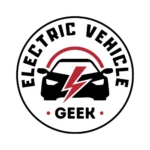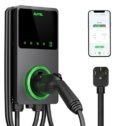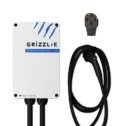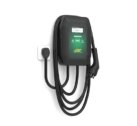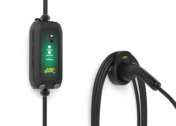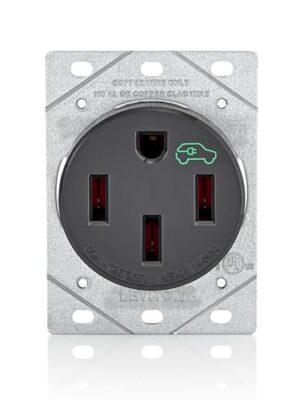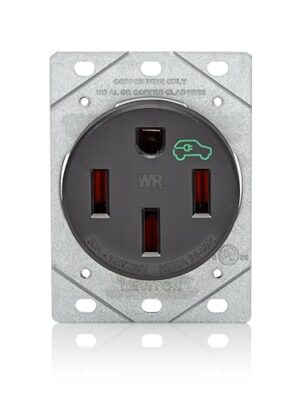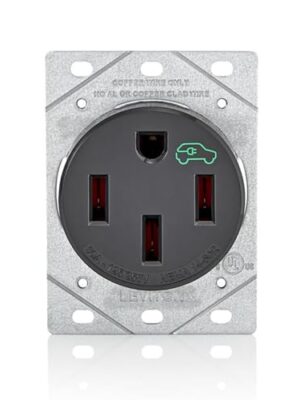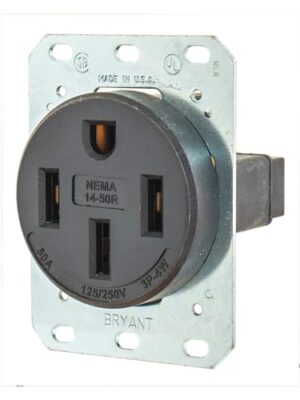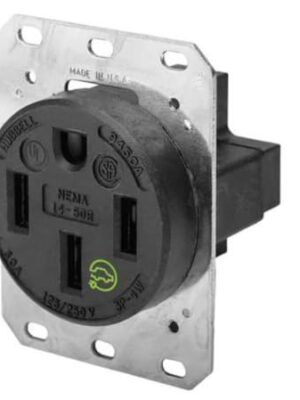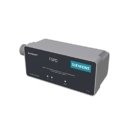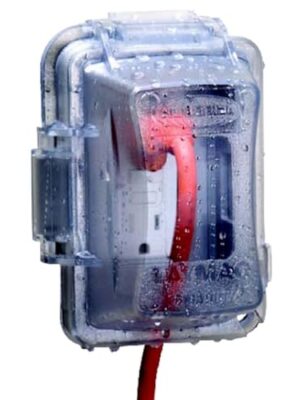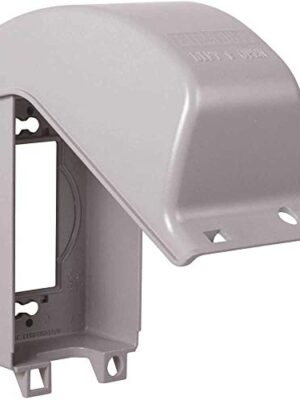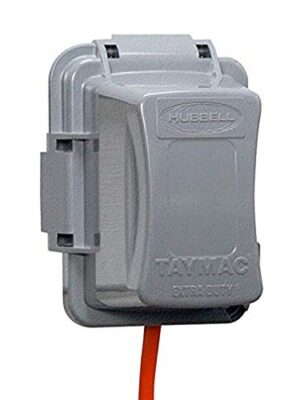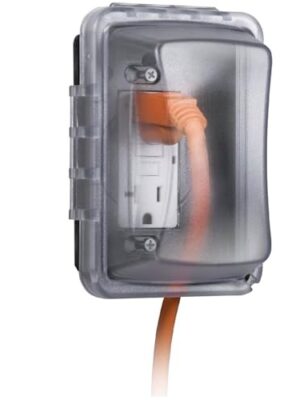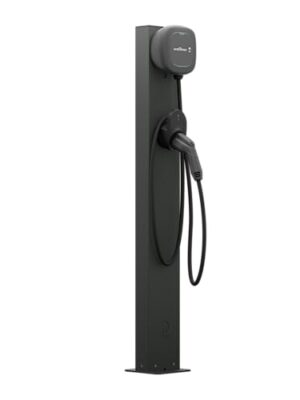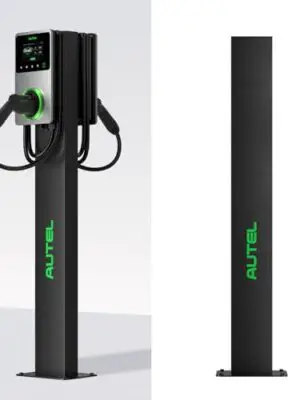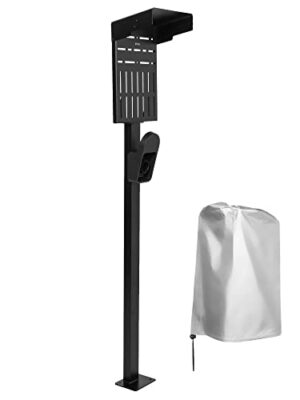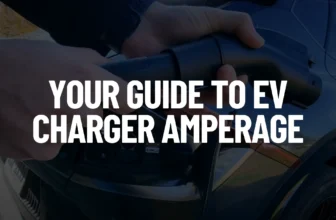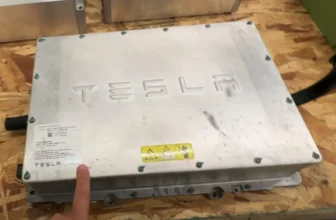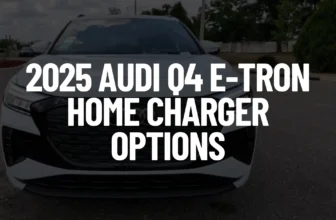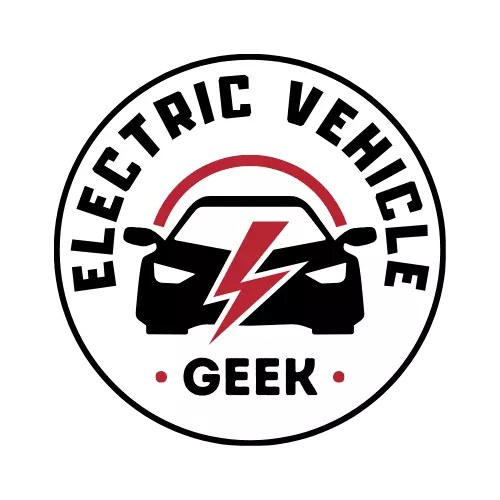The 2025 Jeep Wrangler 4xe blends rugged, trail-rated performance with a 17.3 kWh plug-in hybrid battery, giving you up to 22 miles of electric-only range and a total range of 370 miles. While that EV range is perfect for short commutes, errands, or daily use in EV mode, managing EV charging range anxiety effectively with the 4xe begins with a reliable home charging setup you can trust every day.
This guide is our updated, field-tested version of the original Best Jeep 4xe Charger guide we published on Jeep Runner. Since then, we’ve refined our EV installation methods, upgraded to new EV chargers, and learned firsthand what works for 4xe owners who want dependable, real-world charging.
We’ve also learned what to avoid. One of the most common mistakes is overlooking safety and security features when choosing a charger for the Jeep 4xe. Low-quality chargers or improper installations can cause low input voltage, damage the vehicle’s charging system, blow fuses, or even lead to a faulty charging module, all of which can trigger the dreaded 2025 Jeep 4xe charging red light or service charging system error.
We’ve also upgraded how we approach outdoor EV charger setups for the Jeep 4xe, with a strong focus on long-term safety and durability. This guide isn’t just theory; it’s based on real-world installations we’ve personally completed, tested, and used daily on our Jeep 4xe. We cover the chargers we currently recommend, common mistakes to avoid, and the exact setups we’d choose if we were starting from scratch today.
Let’s dive into what it takes to keep your Wrangler 4xe charged, safe, and trail-ready at home
Table of Contents
- Our Top Picks for Jeep 4xe Home Charging
- Charging Basics for the 2025 Jeep Wrangler 4xe
- Best Level 2 EV Chargers for the Wrangler 4xe
- Installation Tips
- Key Installation Tips for Your Jeep Wrangler 4xe Level 2 EV Charger
- Mounting Location
Our Top Picks for Jeep 4xe Home Charging
To get the most out of your Jeep 4xe, we recommend investing in a 32-amp Level 2 SAE J1772 charger with built-in safety features. These chargers not only provide faster, more efficient charging at home but also help prevent common Jeep 4xe charging issues like “Service Charging System” errors, IDCM faults, and unstable power delivery.
Below is a summary of our quick roundup of top picks that pair perfectly with the Jeep 4xe for safe, reliable, and consistent performance. Don’t worry, though, you can easily jump to the detailed reviews below to learn how each charger stacks up in real-world use, what features matter most for the 4xe, and which model best fits your home setup and needs.
Grizzl-E Smart EV Charger Review Best seller
Autel AC Elite In-Body Holster EV Charger Review
Grizzl-E Classic EV Charger Review
Battery Tender eCharge 48 AMP EV Charger Review
Charging Basics for the 2025 Jeep Wrangler 4xe
The 2025 Jeep Wrangler 4xe is a plug-in hybrid that combines off-road capability with electric efficiency. It uses a 17.3 kWh lithium-ion battery and comes equipped with a 7.7 kW onboard charger, making it compatible with both Level 1 and Level 2 AC charging.
Its all-electric EPA-rated range is 21 miles (34 km), with a combined fuel economy rating of 49 MPGe, equivalent to approximately 73 kWh/100 mi or 45.4 kWh/100 km.
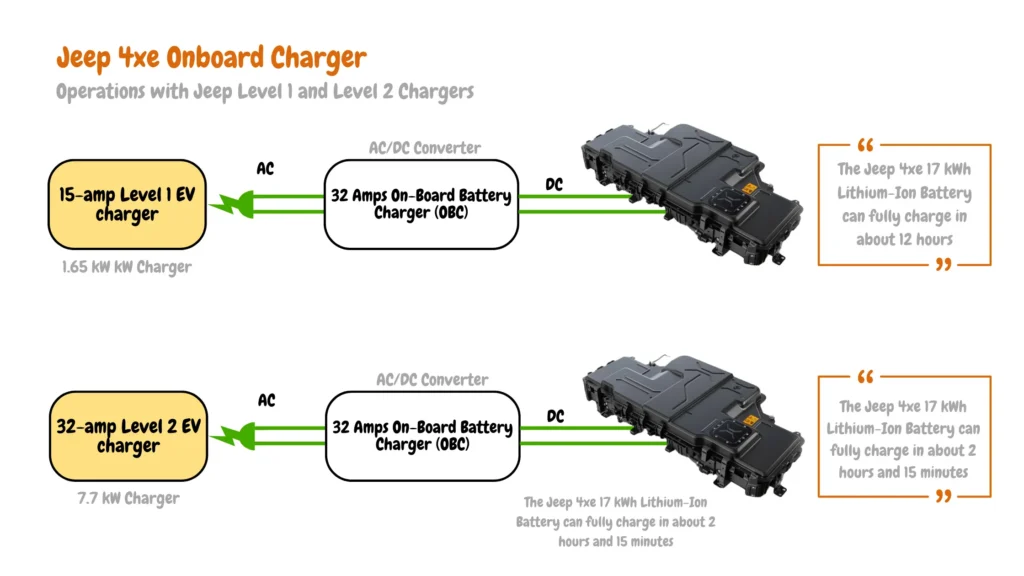
Knowing the difference between Level 1 and Level 2 charging is key to choosing the right EV charger for your Jeep 4xe. Here’s what to expect in terms of electrical requirements, charging time, and costs:
| Charger Type | Power Source | Power | Time to Full | Estimated Cost (at $0.15/kWh) |
|---|---|---|---|---|
| Level 1 (120V) | 120V outlet | 1.4 kW | 12–14 hrs | $2.64 |
| Level 2 (240V/32A) | 240V circuit | 7.7 kW | 2–3 hrs | $2.64 |
Level 1 Charging
Level 1 charging uses a standard 120V household outlet and delivers approximately 1.4 kW of power. Recharging a depleted Jeep Wrangler 4xe’s 17.3 kWh lithium-ion battery from 10% to 80% can take around 12 hours using the included Jeep 4xe Level 1 charger.
The Level 1 charger shown in the image below typically comes included with the 2025 Jeep Wrangler 4xe and is best suited for light, overnight top-offs or for drivers who don’t fully deplete the battery each day.
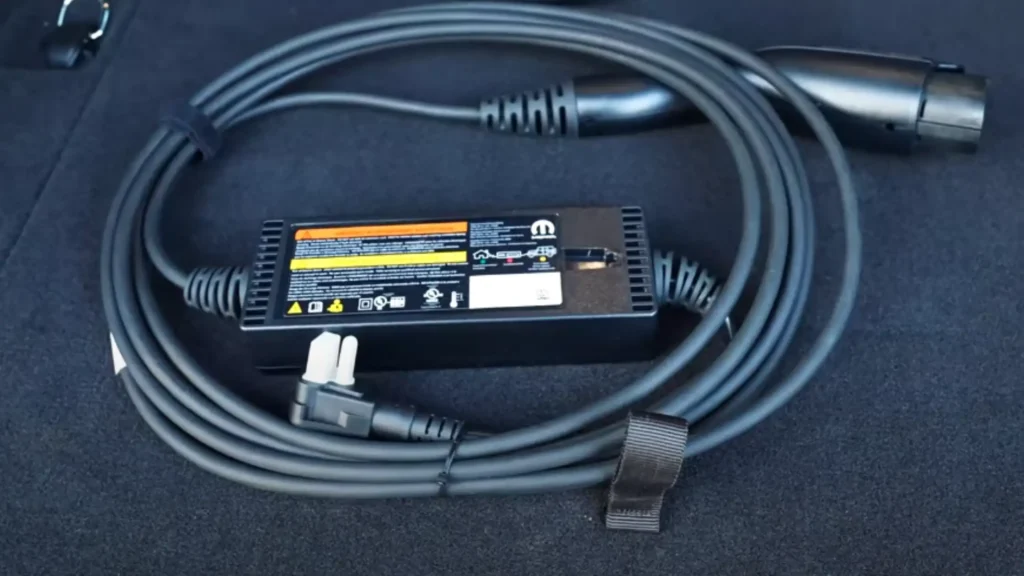
While it’s a convenient starting point, we recommend upgrading to a Level 2 EV charger for significantly faster charging, advanced safety protections, and smart EV charging features that better support daily use.
Level 2 Charging
Level 2 charging is a major upgrade for Jeep 4xe owners seeking faster, safer, and more consistent charging. Thanks to its 7.2 kW onboard charger (drawing up to 32 amps), the 4xe can charge from 10% to 80% in about 2 hours. This faster turnaround is especially valuable for drivers who use cabin preconditioning or power external accessories like the Jeep Power Box, which can quickly drain the battery between trips.
We interviewed 20 Jeep 4xe owners for this guide, and 90% of them started with the Level 1 charger but eventually upgraded to a Level 2 EV charger, not just for faster charging speeds, but for the added smart EV charging features like scheduled charging, energy monitoring, and load balancing, along with built-in safety protections like ground fault detection, temperature sensors, surge protection, and auto-restart logic.
How Charger Quality Affects the Jeep Wrangler 4xe’s Battery Health and Efficiency
A high-quality Level 2 charger (up to 32 amps) delivers clean, stable power with minimal voltage fluctuation and heat buildup. This aligns with the Jeep Wrangler 4xe’s 7.2 kW onboard charger, ensuring full compatibility and efficient charging without overloading the system.
Using a higher-amperage charger, like a 40-amp unit, offers no speed benefit, since the 4xe can’t accept more than 32 amps, but may increase heat and internal strain, especially if the charger lacks current-limiting settings. Sticking to a properly matched 32-amp charger or using a low-amperage Level 1 EV charger helps reduce electrical stress, protect vehicle components, and slow long-term battery degradation.
Lower-quality chargers can cause power fluctuations that lead to battery cell imbalance, excess heat, and faster chemical degradation, all of which can shorten the Jeep 4xe’s battery lifespan, even without the use of DC fast charging.
Compared to Level 1 charging, Level 2 chargers are significantly more efficient for the Jeep 4xe, often achieving up to 90% efficiency. Faster charging shortens the duration that the vehicle’s internal systems, such as the Battery Management System (BMS), thermal management, and control electronics, remain active. In contrast, Level 1 charging keeps these systems “awake” much longer, increasing parasitic energy loss. As a result, overall charging efficiency with Level 1 can drop to around 80%, with more energy wasted running vehicle systems instead of charging the battery.
Efficient Jeep 4xe chargers waste less power as heat and typically convert over 90% of energy from the wall into usable charge, while Inefficient units can increase charging times and energy costs while generating unnecessary heat.
Reliable power delivery also supports the Jeep’s 4xe’s Battery Management System, which monitors charging conditions to balance cells and protect the battery. Inconsistent power input from low-quality EV chargers can interfere with this process.
Finally, charging in extreme temperatures, topping off to 100% daily, or letting the battery drain to 0% will accelerate degradation. That’s why we recommend Smart EV chargers with scheduled charging or thermal monitoring to help reduce these risks.
Best Level 2 EV Chargers for the Wrangler 4xe
You don’t need a high-amperage EV charger like a 40A, 48A, 50A, or 80A unit for the Jeep 4xe. The 4xe’s onboard charger is limited to 32 amps (7.2 kW), so using a higher-rated charger offers no charging speed advantage. A well-matched 32-amp Level 2 charger delivers optimal performance, minimizes energy loss, protects internal systems, and helps extend battery life, making it the smart, efficient, and safe choice for long-term use.
A plug-in 32A Level 2 charger can fully recharge the Jeep 4xe in under 2 hours, plenty fast for daily errands and commuting, without the added cost of high-amperage units or the panel upgrades they often require. A portable 32A charger also gives you more flexibility for lifestyle-based charging: it’s easy to bring on the road, use at a cabin, or move between properties when needed.
Instead of overpaying for a costly high-amperage charger that the 4xe will never fully utilize, we recommend focusing on a portable 32A charger with smart EV charging features like load balancing, scheduled charging, and real-time monitoring. Prioritize EV chargers with built-in safety protections such as ground fault detection, overcurrent protection, temperature sensors, and surge protection, especially for outdoor setups or garages with wide temperature swings.
How We Tested Them
The best home EV charger depends on your specific needs, but we focused on finding the optimal balance of safety, value, build quality, smart features, and usability, especially for Jeep 4xe owners.
At Electric Vehicle Geek, safety is our top priority. We evaluated each charger for critical EV charging safety features that support reliable daily use. That includes a secure J1772 connector with high-quality contact pins that ensure a clean mating process. This physical connection initiates a proper handshake protocol, verifying voltage, grounding, and current limits before power delivery begins. A poor handshake can cause charging errors (red light) or long-term issues like wear on the Jeep 4xe’s inlet, damage to its integrated dual charging module (IDCM), or degradation of the battery pack.
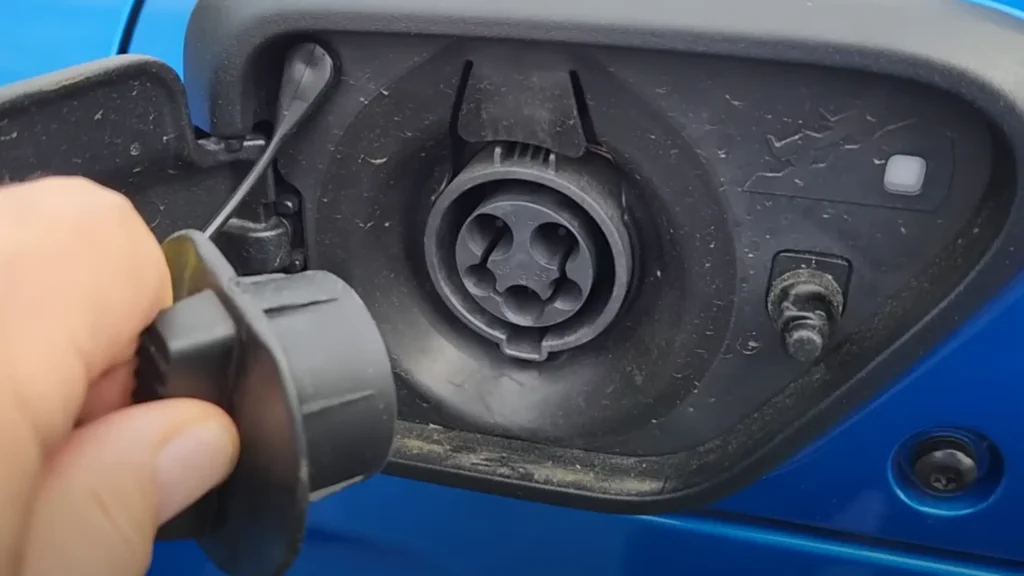
We also evaluated how well each charger integrates with the Jeep 4xe’s onboard systems, especially when using smart EV charging features like scheduled charging, load balancing, and energy monitoring.
Pricing played a critical role in our selection process. We evaluated the total cost of ownership, factoring in the base unit price, and compared it directly to OEM options like the Jeep Level 1 charger and the Mopar® TurboDX Level 2 charger. To ensure real-world value, all of our top picks are priced below the Mopar® TurboDX’s $565.00 MSRP, offering more functionality without exceeding OEM pricing.
Finally, we assessed real-world durability, NEMA ratings, and design. While aesthetics may be less critical for chargers hidden inside a garage, they matter when mounting outdoors or in visible locations. For Jeep 4xe drivers who take their lifestyle vehicle off-grid, we also prioritized portable 32A chargers that could handle outdoor use, weather fluctuations, and rough conditions without compromising performance.
Top Picks for the 4xe
#1 Grizzl-E Smart EV Charger
Grizzl-E Smart EV Charger Review Best seller
The Grizzl-E Smart is one of the few EV chargers I’ve installed that strikes the perfect balance between ruggedness, intelligence, and real Jeep 4xe compatibility. It builds on the rock-solid design of the original Grizzl-E but adds Wi-Fi connectivity through the Grizzl-E Connect platform, giving you access to real-time charging data, usage stats, and scheduling features that work and don’t get in the way.
With up to 40 amps of adjustable output, the Grizzl-E Smart delivers up to 30 miles of range per hour. That’s more than enough to fully charge the 4xe overnight, even if you’re arriving home late and heading back out early. For those dealing with limited panel capacity, amperage can be dialed back to 32A, 24A, or 16A, depending on your breaker and wiring, and the charging logic adjusts accordingly. No special hardware or electrician reconfiguration is needed, just plug it in and set it once.
Jeep 4xe owners will appreciate the charger’s consistency. I’ve worked with several so-called “smart” chargers that freeze up during the initial handshake or fail when your Wi-Fi signal drops. This is exactly the kind of delay that can confuse the 4xe’s Integrated Dual Charging Module (IDCM), causing it to throw codes like “Service Charging System” or worse, triggering battery or hybrid fault lights. The Grizzl-E Smart avoids those issues by continuing to charge reliably even if the connection to the app is lost.
Physically, the Grizzl-E Smart is built like a tank, just like the Jeep 4xe. The NEMA 4X enclosure is metal, not plastic, and it’s UL-tested and Energy Star certified. I’ve mounted it outdoors in exposed locations with full sun and snow, and it hasn’t missed a beat. That matters because the 4xe is known to throw plug status fault warnings when exposed to high heat or moisture from cheap plugs. The Grizzl-E’s cable is now thinner and easier to coil than older versions, but still handles cold and hot weather better than most. The included EasyEvPlug holster is also a welcome upgrade that offers clean, simple, and sturdy plug and cable management.
The Grizzl-E’s strong grounding and power monitoring features also help prevent a class of intermittent 4xe xharging issues that are frustrating to chase down. Poor grounding or inconsistent voltage can cause the Jeep 4xe to shut down charging unexpectedly, or worse, require a dealer visit just to clear a stuck fault code. I’ve had installations where reseating fuse 9 or opening the hood would temporarily restore charging, which often pointed back to inconsistent EVSE performance. Since switching to the Grizzl-E on those same installs, I haven’t seen those faults return.
The Grizzl-E Smart is the charger I recommend when Jeep 4xe owners want no-nonsense durability, installation flexibility, and smart features that don’t interfere with charging. It solves real-world problems Jeep owners deal with, like flaky handshakes, temperature-related faults, and grounding sensitivity, without making you depend on a fragile app or weak plastic housing. It just works, and that’s exactly what you need when you’re dealing with a hybrid system as particular as the 4xe.
#2 Autel MaxiCharger Home Smart AI EV Charger
Autel AC Elite In-Body Holster EV Charger Review
The Autel MaxiCharger Smart AI is one of the smartest and most refined Level 2 chargers I’ve installed, and it’s particularly well-suited to the quirks of the Jeep 4xe. With up to 40 amps of output and full support for both NEMA 14-50 and 6-50 plugs, it charges fast while offering flexible installation options. You can scale it down to 6 amps if needed, which can help avoid panel upgrades or reduce strain on shared household circuits. For Jeep 4xe owners dealing with tight electrical budgets or older homes, that adjustability is a big win.
The Jeep 4xe is sensitive to handshake timing, voltage irregularities, and smart charger delays, especially when Wi-Fi or firmware updates create inconsistencies. What sets the Autel apart is how smoothly it handles this. With dual Wi-Fi and Bluetooth connections plus optional Ethernet, it maintains a stable connection with its app and doesn’t cause the kind of delay loops that have triggered Plug Status Fault Warnings or “Service Charging System” errors in my past installs. I’ve had multiple cases where switching from a laggy cloud-based charger to the MaxiCharger immediately resolved these issues, especially in garages with weak Wi-Fi.
Autel’s mobile app is among the best I’ve used. It lets you schedule charging, monitor energy use, and lock out unauthorized use with RFID cards if needed. These features work smoothly, and they don’t interfere with the Jeep’s onboard charging system. For those trying to work around off-peak rates or load-sharing in homes with solar, this smart integration can make a real difference in cost and system stability.
The Autel’s 25-foot cable is high quality and resists curling or stiffening, even in winter. The holster is integrated into the body of the unit, which helps keep the charging pin clean and prevents grounding issues caused by dirty or wet contacts, a known trigger for Jeep 4xe plug faults. Its weatherproof NEMA 4-rated enclosure and CSA safety certification also give peace of mind if you’re installing in a detached garage or charging outdoors. Temperature changes can cause cheap EVSEs to glitch or overheat, which the Jeep 4xe is quick to flag. I’ve never had thermal faults logged with the Autel, even during back-to-back charging sessions in 90°F heat.
If you’ve ever had to reseat fuse 9 to reboot the IDCM, you know how sensitive the Jeep 4xe can be to EVSE power quality. The Autel maintains a stable and clean output during charging and restart sequences, which helps avoid those sudden no-charge conditions that some 4xe owners experience after voltage dips or brief outages. I’ve had customers report smoother starts and no repeated DTCs after moving to this unit.
#3 Grizzl-E Classic EV Charger
Grizzl-E Classic EV Charger Review
The Grizzl-E Classic is one of the most rugged and reliable Level 2 chargers I’ve tested on a Jeep Wrangler 4xe, and it’s a smart match for Jeep 4xe drivers who’ve run into charger compatibility issues. It’s built like a tank, with a powder-coated metal housing that’s IP67 rated and ready for year-round use outdoors or in detached garages.
The Grizzl-E Classic is a dumb Level 2 charger with no app, Bluetooth, or cloud software to get in the way of the Jeep 4xe’s sensitive charging process. That might sound like a drawback if you’re into smart home tech, but it’s exactly what makes this charger so dependable. Without delays from apps, Wi-Fi dropouts, or automatic firmware updates, it avoids the frustrating issues many 4xe owners face, like “Plug Status Fault” or “Service Charging System” errors. It starts charging as soon as you plug it in, handles power outages without a problem, and resets automatically when power is restored, no extra steps required.
The Grizzl-E delivers up to 40 amps of power, with dip-switch settings inside that let you reduce the amperage to 32, 24, or 16 amps, depending on your breaker. This is huge for homes where the electrical panel is near capacity. You can dial the output down to match your circuit instead of shelling out for an expensive panel upgrade, and that lower current helps prevent undervoltage conditions that sometimes cause the 4xe’s Integrated Dual Charging Module to throw fault codes.
Low voltage and poor ground quality are notorious triggers for 4xe charging lockouts. This charger’s internal protection system keeps current clean and consistent, and its built-in ground fault protection is solid. I’ve had Jeep owners come to me after multiple dealership visits, thinking they needed a new charging module, only to find the culprit was a charger with noisy output or a poor ground. Switching to the Grizzl-E Classic fixed the problem, and in one case, cleared a persistent high-voltage interlock fault within a few charge cycles.
The 24-foot cable is thick yet flexible, and the connector fits tightly and securely. That matters more than most people realize. Many Jeep 4xe charging ports eventually develop intermittent contact issues, and loose plugs or worn pins can make the problem worse. The Grizzl-E’s J1772 connector holds firm and makes a clean, solid connection without putting excess strain on the inlet or control pins. This helps reduce wear and prevents the Jeep from throwing plug status fault errors, a common issue I’ve seen even when the cable and connector look perfectly fine. So far, I haven’t experienced that with this unit.
#4 Battery Tender eCharge 32 AMP EV Charger
Battery Tender eCharge 32 AMP EV Charger Review
The eCharge 32 delivers up to 7.6kW of charging power, which translates to about 28.5 miles of range per hour, more than enough for overnight top-offs on the Jeep 4xe. It’s a great fit for daily use, whether you’re commuting, running errands, or charging between weekend trips.
It comes as a full kit with a wall bracket, plug holster, NEMA adapters, and a carry bag. The charging cable is surprisingly flexible even in cold weather, which isn’t something you can say for many chargers in this price range. Build quality is solid and gives confidence that it’s built to last.
The J1772 connector fits securely into the 4xe’s charge port with no signs of looseness or pin alignment issues. I’ve worked with cheaper units where the connector was sloppy or misaligned, which can cause damage to the 4xe’s charging inlet or lead to inconsistent charging sessions. That’s not a concern with this charger.
Support for both 120V and 240V charging using true NEMA 14-50 and 5-15 adapters makes the eCharge 32 an excellent choice for flexible use at home or on the road. It’s especially useful for Jeep 4xe owners dealing with tight panel capacity because you can manually select between 32A, 24A, and 16A charging levels. That adjustability can help you avoid expensive service panel upgrades by allowing the charger to match whatever amperage your circuit can safely deliver.
App-connected chargers may sound convenient, but they often introduce handshake delays or Wi-Fi interruptions that confuse the Jeep 4xe’s charging system. The eCharge 32 avoids that completely. It’s a plug-and-charge device with no app, no firmware update delays, and no cloud-based complications. For a vehicle like the 4xe that can be sensitive to handshake timing, that kind of simplicity matters more than you might expect.
For anyone charging in outdoor conditions or garages with extreme temperature swings, the built-in over-temperature protection and IP66 weather rating offer meaningful peace of mind. I’ve seen 4xe charging faults and warnings come from heat-related connector issues in cheaper EVSEs, especially in hot garages. The eCharge 32 has stayed stable in those same environments.
Its lightweight and compact build make it a great option for Jeep owners who need mobility. Whether you’re charging in your garage, at a remote cabin, or during an off-road trip, this charger gives you the performance and flexibility to support the Jeep lifestyle without compromise.
Installation Tips
Now that you’ve purchased a compatible EV charger for your Jeep Wrangler 4xe, it’s important to focus on proper installation. We’ve seen Jeep Wrangler 4xe charging issues occur even with high-quality, compatible chargers, often because of problems with the branch circuit powering the charger. In many cases, wiring issues, grounding problems, or improper breaker sizing are just as responsible for 4xe charging faults as the charger itself.
Taking the time to get the installation right can help prevent common Jeep Wrangler 4xe charging issues such as charging failures, grounding problems, low input voltage, “Service Charging System” warnings, or even short circuits during charging.
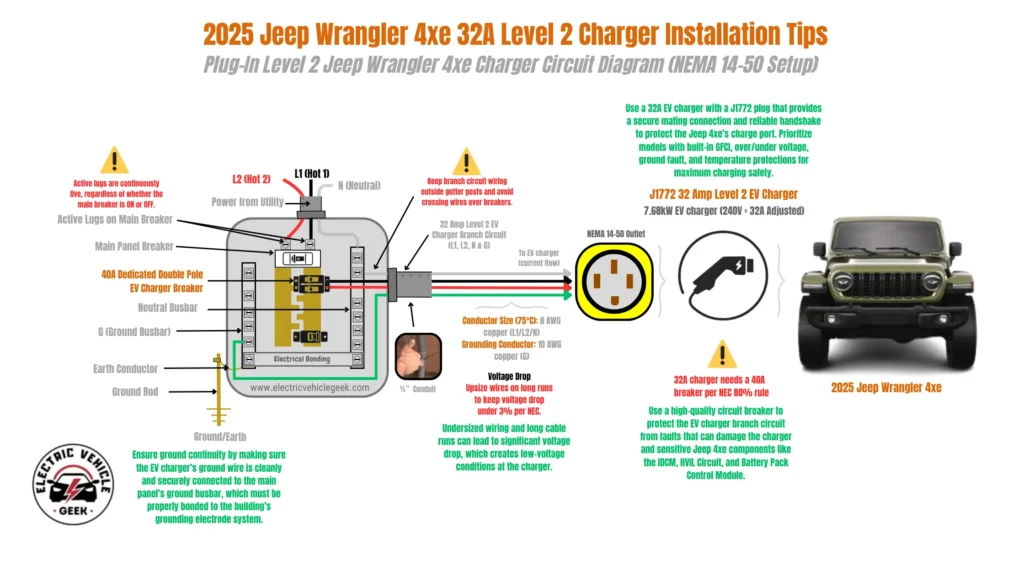
For step-by-step help, we recommend reading our Jeep 4xe Level 1 Charger Installation Guide and Level 2 Jeep 4xe Charger Installation Guide. These dedicated resources cover everything from outlet selection and breaker sizing to wiring requirements and grounding.
Key Installation Tips for Your Jeep Wrangler 4xe Level 2 EV Charger
When installing a Level 2 EV charger for your 2025 Jeep Wrangler 4xe, following best practices can significantly improve charging reliability, prevent common Jeep Wrangler 4xe charging issues, and protect critical components. Here are several expert-backed tips drawn directly from our installation guide.
Use a 32A Charger with a Quality J1772 Plug
Choosing the right charger starts with proper compatibility. We recommend using a 32-amp EV charger equipped with a high-quality J1772 plug that provides a secure, well-aligned connection. A good physical mating and handshake help prevent damage to the Jeep 4xe’s charge port, a common issue with looser-fitting plugs.
Look for EV chargers that also include essential inbuilt EV charging safety features such as built-in GFCI, overvoltage, undervoltage, ground fault, and overtemperature protection. These features safeguard both the charger and your vehicle.
Install a High-Quality Breaker for Circuit Protection
To safeguard both your EV charger and the sensitive electrical components in your Jeep 4xe, such as the Integrated Dual Charging Module (IDCM), High Voltage Interlock Loop (HVIL), and Battery Pack Control Module, you must use a high-quality, UL-listed dedicated EV charger circuit breaker.
Always size your EV charger circuit breaker according to NEC 625.41, which classifies EV charging circuits as continuous loads and requires the overcurrent protection device to be rated at 125% of the charger’s maximum continuous current. This means a 32A EV charger must be installed on a 40A breaker. Using an undersized breaker can cause nuisance tripping, while an oversized one may fail to protect the circuit properly. Correct breaker sizing ensures both safety and reliable charging performance.
Avoid low-cost, generic, or aging breakers, which may fail to trip during fault conditions or nuisance-trip under normal load, risking damage to both the EVSE and your vehicle’s internal charging systems. Choose breakers from reputable brands that are properly matched to your panel type and rated for continuous duty.
Proper circuit protection ensures reliable operation, reduces fire hazards, and preserves the long-term health of your Jeep’s high-voltage systems.
Choose a High-Quality NEMA 14-50 Outlet
For plug-in installations, use an industrial-grade NEMA 14-50 outlet that provides firm contact with the EV charger plug. Low-grade or worn outlets can lead to arcing, poor conductivity, and heat buildup, all of which can cause intermittent charging failures or temperature-related faults. A tight, reliable connection at the outlet reduces these risks and ensures consistent power delivery.
Best NEMA 14-50 EV Charging Outlet
We recommend high-quality, industrial-grade NEMA 14-50 outlets, like the Leviton 1450R (indoor), Leviton 1450W (weather-resistant outdoor), Bryant 9450FR, and Hubbell HBL9450A, for Jeep Wrangler 4xe Level 2 charger installations.
The NEMA 14-50 outlets listed above exceed basic code requirements and are trusted by experienced EV installers for their durability, secure connections, and long-term safety under high-amperage continuous EV charging loads over extended periods of time.
For outdoor garages or carports, the Leviton 1450W is a top pick. It features a weather-sealed housing and corrosion-resistant contacts that hold up against moisture, dirt, and seasonal exposure. When paired with a properly installed 40A breaker and 6-8 AWG solid copper wire, these outlets can deliver a full 32 amps of continuous EV charging loads, translating to 28–30 miles of range per hour of charging without overheating or nuisance EV charger circuit breaker tripping or warning Jeep 4xe charging red lights indicating charging issues.
What truly sets these outlets apart is their mating quality and handshake reliability with J1772 plugs, especially on chargers we recommend like the Grizzl-E Smart. We’ve seen cheap NEMA 14-50s cause loose fits, shallow contact, or worn terminals, all of which lead to intermittent charging, ground faults, or even red warning lights on the Jeep 4xe charging port.
Premium outlets like Leviton, Bryant, and Hubbell maintain solid plug engagement, consistent conductivity, and stable grounding, critical for the Jeep 4xe’s onboard charging logic, which is highly sensitive to voltage irregularities.
Always use solid copper wire, not aluminum, and follow torque specs carefully. Many failed installs trace back to under-torqued terminals or poor wire prep. Getting the connection right from day one prevents the common “worked fine for a week, then stopped charging” scenario.
Whole-House Surge Protection for Jeep 4xe Charging
We strongly recommend installing a whole-house Type 2 surge protector like the Siemens BoltShield FSPD140.
Siemens Boltshield FSPD140 Whole-House SPD for EV Charger Protection
The Siemens BoltShield FSPD140 mounts directly to your main panel and provides robust protection against power surges that could damage your EV charger or sensitive components in your vehicle’s charging system.
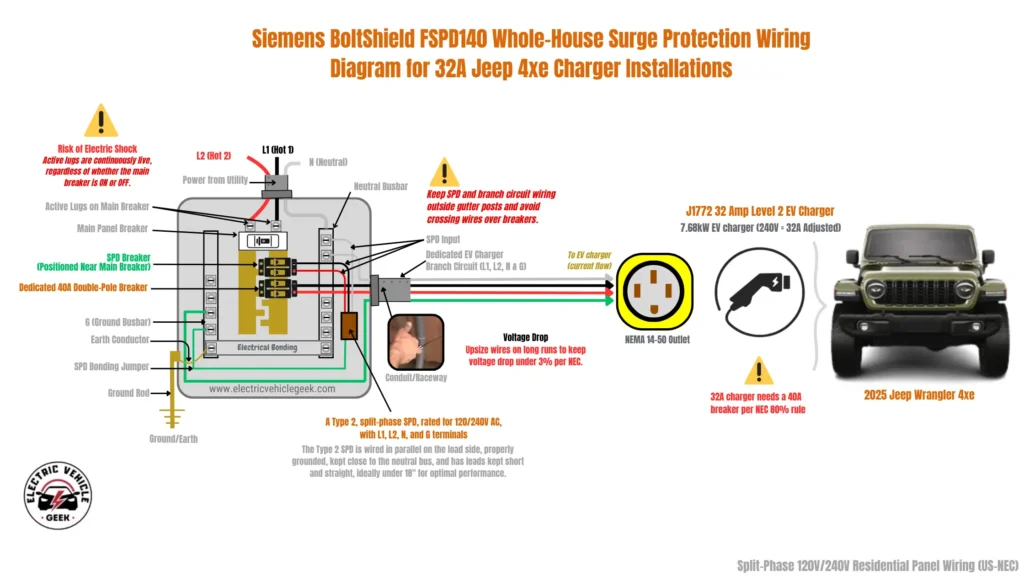
While a surge protector won’t prevent low-voltage issues or onboard faults in the 4xe, it does guard your Jeep Wrangler 4xe charger installation against sudden voltage spikes caused by lightning, utility grid switching, or large appliances cycling on and off. Installing the FSPD140 helps protect the dedicated EV charger circuit, as well as all other circuits in your home, offering a smart, long-term investment in electrical system reliability and EV charging safety.
Learn more: EV Charger Surge Protection Guide
Use Solid Copper Conductors, Properly Sized for the Circuit
Use solid copper wire for your EV charger branch circuit, and not aluminum. Solid copper provides superior electrical conductivity, mechanical strength, and thermal durability, making it ideal for continuous load applications like EV charging.
Always size conductors properly based on your EV charger’s continuous load and the corresponding circuit breaker amperage. According to the NEC 80% rule for continuous loads (NEC 210.20(A) and 625.41), a 32-amp EV charger must be installed on a 40-amp breaker (32A × 1.25 = 40A). Based on NEC Table 310.16, this typically requires:
- 8 AWG solid copper for L1, L2, and Neutral
- 10 AWG solid copper for the Ground (per NEC 250.122)
If your wire run exceeds 75 to 100 feet, upsize the conductors (e.g., to 6 AWG) to keep voltage drop under 3% in compliance with NEC 210.19(A)(1) guidance.
Proper wire sizing helps minimize voltage drop, prevent overheating, and maintain ground continuity, all critical for protecting your EV charger, branch circuit, and sensitive components in the Jeep 4xe, like the Integrated Dual Charging Module (IDCM) and Battery Pack Control Module.
Prioritize Ground Continuity
Proper grounding is critical for safety and consistent operation. The EV charger’s ground wire should be cleanly and securely bonded to the main electrical panel’s ground busbar, which must also be correctly tied to the building’s grounding electrode system. Poor ground continuity can lead to nuisance faults or even unsafe charging conditions.
Check out our EV Charger Grounding & Earthing Guide
Watch Out for Voltage Drop
Long wire runs or using conductors that are too small can result in significant voltage drop, especially at 32 amps. This can cause charging errors or slow performance. To stay within National Electrical Code (NEC) guidelines, keep voltage drop under 3% and upsize wire gauge when necessary.
Mounting Location
Indoor Garage-Mounted Chargers
Indoor garage-mounted chargers are the gold standard for Jeep 4xe installations. Mounting the unit on an interior wall keeps it protected from temperature swings, direct sunlight, and moisture. It also simplifies conduit runs and minimizes long cable stretches that can increase voltage drop.
Outdoor-Mounted Chargers
For outdoor EV charger setups, always protect your NEMA 14-50 outlet with a durable, weather-rated in-use cover. Look for models labeled “extra duty”; they’re built to handle the heavier, more rigid plugs used in Level 2 charging and can withstand frequent use without cracking or warping.
We’ve seen outlets fail prematurely when covered with cheap, ill-fitting covers. Loose-fitting lids can allow moisture in, leading to corrosion, tripped dedicated EV charger circuit breakers, or even melted plugs. In several installs, upgrading to a heavy-duty TayMac outlet cover resolved intermittent charging issues caused by water ingress or poor plug seating.
Top Outlet Covers We Recommend
We recommend the TayMac MM420C for tight clearance installs thanks to its clear, vertical-mount design. For added durability and a secure latch, the TayMac MX3200 RaynGuard offers a heavy-duty metal construction. If you’re using angled plugs or a bulky EV charger cord, the TayMac MM720G’s jumbo size provides extra space and protection. For flexible mounting, the TayMac MM410C works both horizontally and vertically, making it a versatile option for most outdoor Jeep Wrangler 4xe outlet setups.
Each of these models offers reliable protection and a snug fit for NEMA 14-50 plugs, helping avoid arcing, corrosion, and plug movement that can lead to intermittent Jeep Wrangler 4xe charging problems.
When security or HOA rules require protection, we suggest adding a lockable EV charger box or shroud, especially for plug-in models like the Grizzl-E.
If you’re installing a Jeep 4xe charger on an EV charger pedestal, especially near driveways or detached garages, make sure the pedestal is properly rated for outdoor use and securely anchored in concrete.
We’ve included a wiring diagram in this guide that shows how to run the Jeep 4Xe charger branch circuit from the main panel to a pedestal-mounted unit.
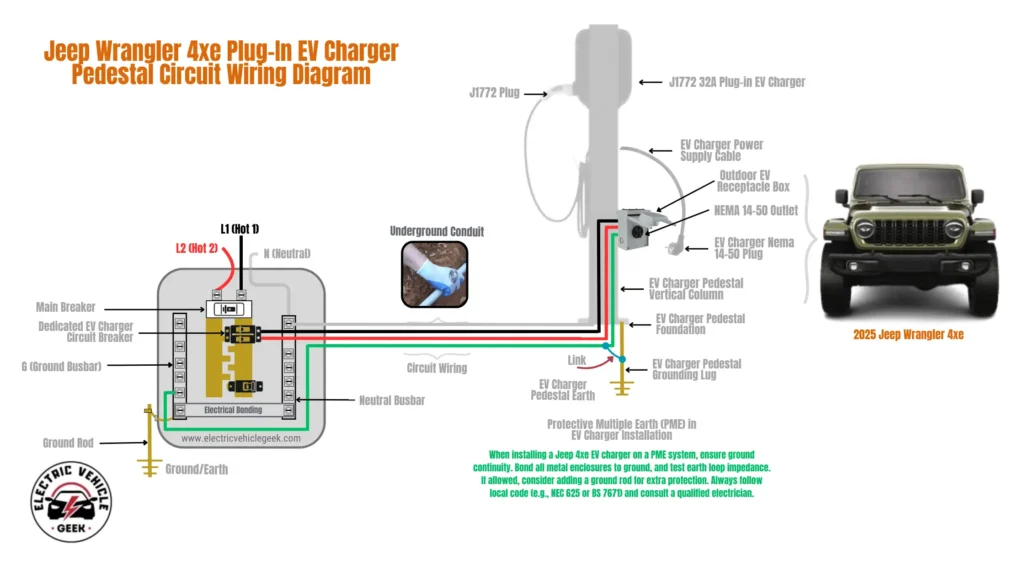
Use schedule 40 PVC or EMT underground conduit buried at least 18 inches deep, and make sure transitions are sealed with appropriate fittings to prevent water intrusion. We’ve also found that using anti-oxidant paste on pedestal terminal connections adds long-term reliability, especially in wet areas.
EV charging cable length is critical. The Jeep 4xe charge port is on the driver’s side front fender, so if you back into the driveway, the cord needs to reach that corner cleanly. We recommend at least 24 feet of cable. We’ve had clients call back after realizing their 16-foot charger cable couldn’t reach the inlet without dragging across the hood or being suspended midair.
Lastly, for Wi-Fi-enabled smart chargers, don’t overlook network signal strength. We’ve had multiple service calls where a charger failed to sync with its app or lost firmware updates due to weak garage Wi-Fi. Install a dedicated repeater or mesh extender within 20 feet of the charger to ensure reliable connectivity. A $30 Wi-Fi extender can save hours of troubleshooting and customer support frustration down the line.

James Ndungu is a certified EV charger installer with over five years of experience in EVSE selection, permitting, and installation. He holds advanced credentials, including certification from the Electric Vehicle Infrastructure Training Program (EVITP) and specialized training in EV charging equipment and installation, as well as diplomas in EV Technology and Engineering Fundamentals of EVs. Since 2021, James has tested dozens of EV chargers and accessories, sharing expert insights into the latest EV charging technologies.
